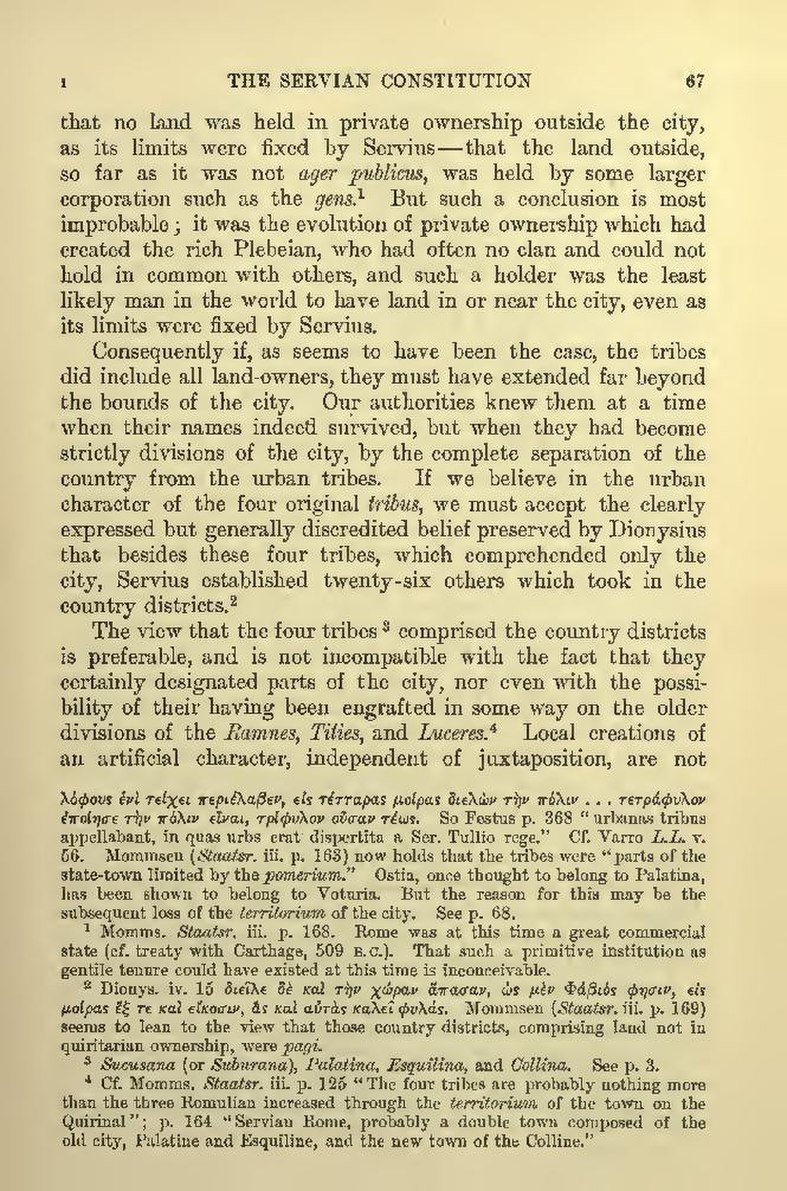that no land was held in private ownership outside the city, as its limits were fixed by Servius—that the land outside, so far as it was not ager publicus, was held by some larger corporation such as the gens.[1] But such a conclusion is most improbable; it was the evolution of private ownership which had created the rich Plebeian, who had often no clan and could not hold in common with others, and such a holder was the least likely man in the world to have land in or near the city, even as its limits were fixed by Servius.
Consequently if, as seems to have been the case, the tribes did include all land-owners, they must have extended far beyond the bounds of the city. Our authorities knew them at a time when their names indeed survived, but when they had become strictly divisions of the city, by the complete separation of the country from the urban tribes. If we believe in the urban character of the four original tribus, we must accept the clearly expressed but generally discredited belief preserved by Dionysius that besides these four tribes, which comprehended only the city, Servius established twenty-six others which took in the country districts.[2]
The view that the four tribes[3] comprised the country districts is preferable, and is not incompatible with the fact that they certainly designated parts of the city, nor even with the possibility of their having been engrafted in some way on the older divisions of the Ramnes, Tities, and Luceres.[4] Local creations of an artificial character, independent of juxtaposition, are not
- [Footnote: [Greek: lophous eni teichei perielaben, eis tettaras moiras dielôn ten polin . . . tetraphylon
epoiêse ten polin einai, triphylon ousan teôs]. So Festus p. 368 "urbanas tribus appellabant, in quas urbs erat dispertita a Ser. Tullio rege." Cf. Varro L.L. v. 56. Mommsen (Staatsr. iii. p. 163) now holds that the tribes were "parts of the state-town limited by the pomerium." Ostia, once thought to belong to Palatina, has been shown to belong to Voturia. But the reason for this may be the subsequent loss of the territorium of the city. See p. 68.]. Mommsen (Staatsr. iii. p. 169) seems to lean to the view that those country districts, comprising land not in quiritarian ownership, were pagi.]
- ↑ Momms. Staatsr. iii. p. 168. Rome was at this time a great commercial state (cf. treaty with Carthage, 509 B.C.). That such a primitive institution as gentile tenure could have existed at this time is inconceivable.
- ↑ Dionys. iv. 15 [Greek: dieile de kai ten chôran hapasan, hôs men Phabios phêsin, eis moiras hex te kai eikosin, has kai autas kalei phylas
- ↑ Sucusana (or Suburana), Palatina, Esquilina, and Collina. See p. 3.
- ↑ Cf. Momms. Staatsr. iii. p. 125 "The four tribes are probably nothing more than the three Romulian increased through the territorium of the town on the Quirinal"; p. 164 "Servian Rome, probably a double town composed of the old city, Palatine and Esquiline, and the new town of the Colline."
